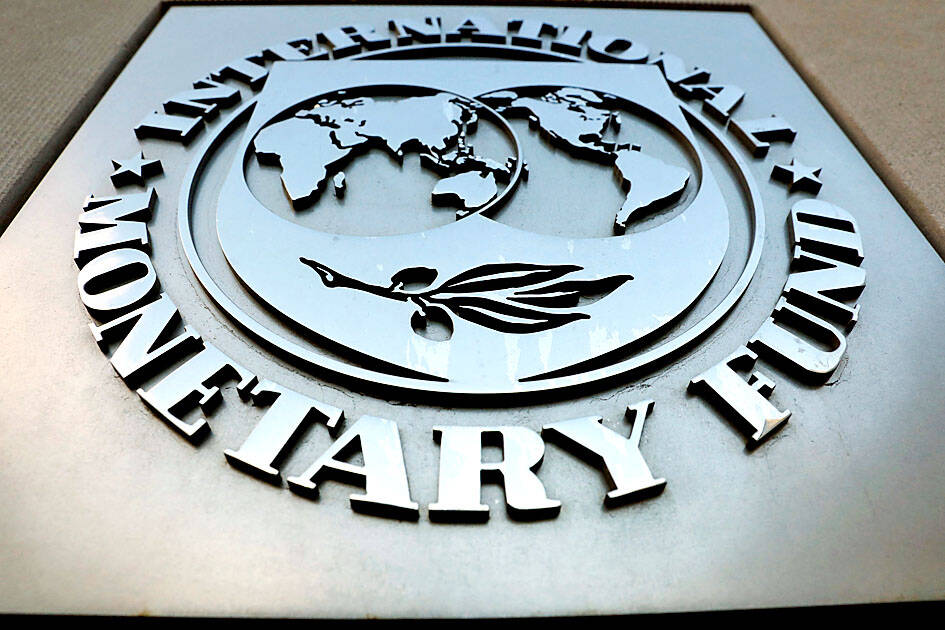Global public debt is expected to reach a record US$100 trillion this year, the IMF said yesterday, warning that the fiscal outlook for many countries might be even “worse than expected.”
In its latest report on fiscal policy, the IMF said it expects global public debt to hit 93 percent of global GDP this year, and to approach 100 percent of GDP by 2030 — 10 percentage points higher than in 2019, before the COVID-19 pandemic.
“Global public debt is very high,” IMF Fiscal Affairs Department deputy director Era Dabla-Norris told reporters ahead of the report’s publication.

Photo: Reuters
“There are very good reasons to believe that the debt burden — or the debt outlook — could be worse than expected,” Dabla-Norris said, pointing to spending pressures to address issues such as climate change, overly optimistic debt projections and the possibility of large amounts of unidentified debt.
“So the bottom line is that it’s time for countries to get their fiscal house in order,” she said.
The IMF report introduced a new “debt at risk” approach to assessing the risks to debt projections.
It estimated that, in a worst-case scenario, global public debt could hit 115 percent of GDP by 2026 — almost 20 percentage points higher than the IMF’s baseline estimate.
The report found that “global factors increasingly drive the fluctuations in government borrowing costs across countries,” suggesting that elevated levels of debt in key countries could “increase the volatility of sovereign yields and debt risks” for others.
Moderating inflation and interest rate cuts in many economies meant now was an “opportune” time for countries to rebuild their fiscal buffers, the IMF said, adding that they were “better placed” than before to absorb the effect of fiscal tightening.
The size of the fiscal adjustment needed to bring global public debt back under control was between 3.0 and 4.5 percent of GDP, on average, it said — almost twice the size of past adjustments.

Taiwan Semiconductor Manufacturing Co (TSMC, 台積電) last week recorded an increase in the number of shareholders to the highest in almost eight months, despite its share price falling 3.38 percent from the previous week, Taiwan Stock Exchange data released on Saturday showed. As of Friday, TSMC had 1.88 million shareholders, the most since the week of April 25 and an increase of 31,870 from the previous week, the data showed. The number of shareholders jumped despite a drop of NT$50 (US$1.59), or 3.38 percent, in TSMC’s share price from a week earlier to NT$1,430, as investors took profits from their earlier gains

In a high-security Shenzhen laboratory, Chinese scientists have built what Washington has spent years trying to prevent: a prototype of a machine capable of producing the cutting-edge semiconductor chips that power artificial intelligence (AI), smartphones and weapons central to Western military dominance, Reuters has learned. Completed early this year and undergoing testing, the prototype fills nearly an entire factory floor. It was built by a team of former engineers from Dutch semiconductor giant ASML who reverse-engineered the company’s extreme ultraviolet lithography (EUV) machines, according to two people with knowledge of the project. EUV machines sit at the heart of a technological Cold

TAIWAN VALUE CHAIN: Foxtron is to fully own Luxgen following the transaction and it plans to launch a new electric model, the Foxtron Bria, in Taiwan next year Yulon Motor Co (裕隆汽車) yesterday said that its board of directors approved the disposal of its electric vehicle (EV) unit, Luxgen Motor Co (納智捷汽車), to Foxtron Vehicle Technologies Co (鴻華先進) for NT$787.6 million (US$24.98 million). Foxtron, a half-half joint venture between Yulon affiliate Hua-Chuang Automobile Information Technical Center Co (華創車電) and Hon Hai Precision Industry Co (鴻海精密), expects to wrap up the deal in the first quarter of next year. Foxtron would fully own Luxgen following the transaction, including five car distributing companies, outlets and all employees. The deal is subject to the approval of the Fair Trade Commission, Foxtron said. “Foxtron will be

INFLATION CONSIDERATION: The BOJ governor said that it would ‘keep making appropriate decisions’ and would adjust depending on the economy and prices The Bank of Japan (BOJ) yesterday raised its benchmark interest rate to the highest in 30 years and said more increases are in the pipeline if conditions allow, in a sign of growing conviction that it can attain the stable inflation target it has pursued for more than a decade. Bank of Japan Governor Kazuo Ueda’s policy board increased the rate by 0.2 percentage points to 0.75 percent, in a unanimous decision, the bank said in a statement. The central bank cited the rising likelihood of its economic outlook being realized. The rate change was expected by all 50 economists surveyed by Bloomberg. The